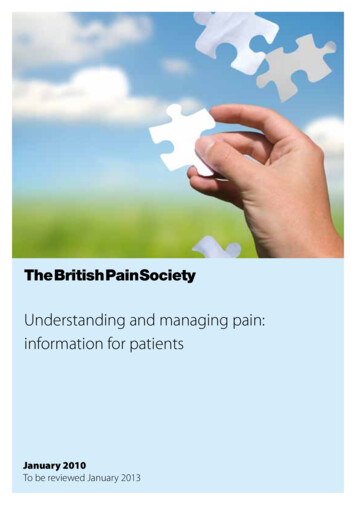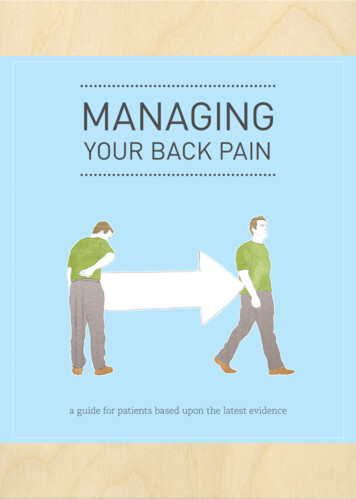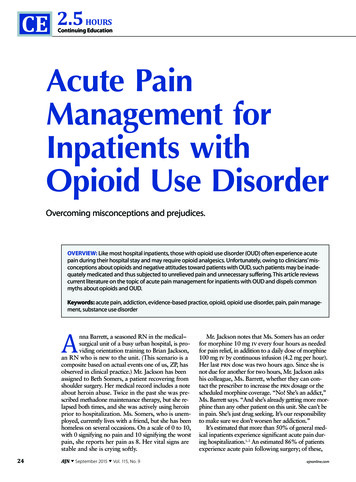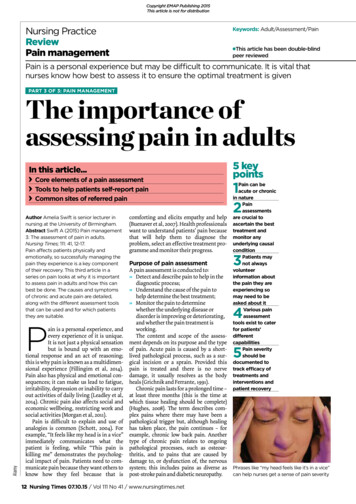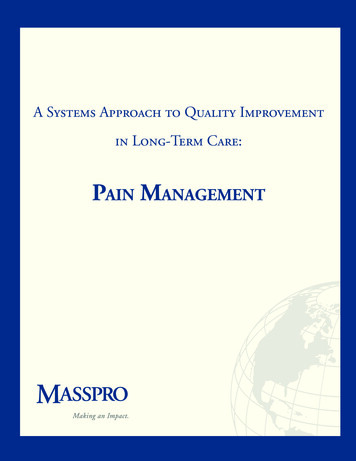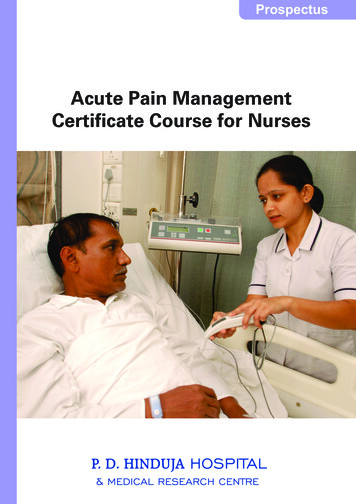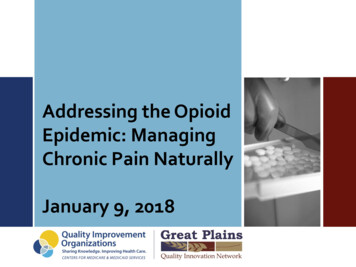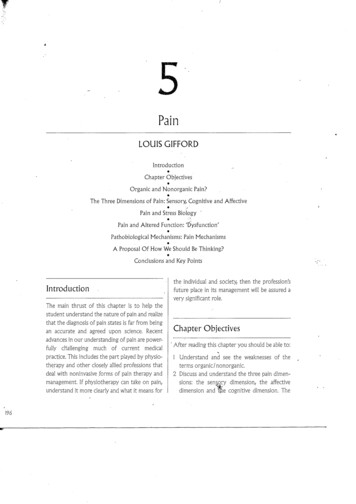
Transcription
PainLOUIS GIFFORDIntroduction Chapter Objectives Organic and Nonorganic Pain? The Three Dimensions of Pain: Sensory, Cognitive and Affective Pain and Stress Biology ' '' Pain and Altered Function: 'Dysfunction 7 Pathobiological Mechanisms: Pain Mechanisms A Proposal Of How We Should Be Thinking? Conclusions and Key PointsIntroductionThe main thrust of this chapter is to help thestudent understand the nature of pain and realizethat the diagnosis of pain states is far from beingan accurate and agreed upon science. Recentadvances in our understanding of pain are powerfully challenging much of current medicalpractice.This includes the part played by physiotherapy and other closely allied professions thatdeal with noninvasive .forms of pain therapy andmanagement If physiotherapy can ta'ke on pain;understand it more clearly and what it means for196the individual and society then the profession'sfuture place in its management will be assured avery significant role.Chapter ObjectivesAfter reading this chapter you should be able to:1 Understand and see the weaknesses of theterms organic/nonorganic.2 Discuss and understand the three pain dimensions: the sensory dimension, the affective «fe dimension and Ine cognitive dimension. The
Pain34567student should be able to relate the paindimensions to all pain experiences and understand that pain's primary purpose is to influence 'behaviour'.Integrate pain into basic concepts of stressbiology:[a] Normal pain is generally an adaptive perceptual message generated by the brain inresponse to tissue damage. Pain does notnecessarily occur at the time of injury.[b] Ongoing pain is adaptive if it serves a protective function but maladaptive if healingis complete and the symptoms are way outof proportion to the stimuli that provokedit.[c] Pain alters psychological/mental function and this markedly alters brain output systems.Discuss the current controversies underlyingthe established pain pathways and the misguided notion that there is a single pain perception centre in the brain.Appreciate the relevance of the pain dimensions to acute and chronic pain.Understand the concept of dysfunction/altered function and relate it to:[a] The patient in pain;[b] The weakness of many modern therapymodels.Understand that there are multiple physiological mechanisms underlying the perception ofany given pain and that the major ones incurrent clinical use by some physiotherapistsare:[a] Nociceptive mechanisms;[b] Peripheral neurogenic mechanisms;[c] Central mechanisms;[d] Output mechanisms - sympathetic;motor, neuroendocrine;[e] Affective/cognitive mechanisms.8 Understand the biological principles underlying the pain mechanisms and relate the processes to clinical presentations.9 Appreciate that there are many controversialissues in ascribing pain solely to a particulartissue or structure.10 Understand the terms 'allodynia' and hyperalgesia and the difficulties of their clinicalinterpretation.11 Understand the weaknesses of therapeuticapproaches to pain that involve targeting apresumed 'source' of the pain and that usewholly passive techniques.Organic and Nonorganic Pain?The notion that pain is a pure sensation akin totaste and smell has received much derision inrecent times [Wall, 1989; Melzack and Wall,1996]. Most of us tend to think of pain as anunpleasant, distressing sensation that originatesin traumatized tissues and courses its way alongneural pathways to the brain and consciousness.Thus, the amount of pain perceived fits with theamount of damage done and the pain happilyrecedes in direct relation to the pace of healing.The problem is that our clinics and departmentsare full of patients who have ongoing pain with noclear trauma or disease process, or who havesuffered trauma but the pain continues on longafter a reasonable healing period. Often there is ahuge discrepancy between the amount of painperceived and evidence of any reasonable tissueabnormality with which to equate it. Time andagain this very discrepancy has promoted theadoption of a two-tier diagnostic model thatdivides patients into 'organic', where observablepathology equates with the pain, and 'nonorganic'197
Louis Giffordor 'psychosomatic' where no such relationshipexists [Waddell et a/., 1980; Waddell and Turk,1992; Long,1995]. Put simply this often equatesto: organic 'we believe you; have an operation/pill / manipulation to fix it'; and nonorganic 'youare making it up, you need to see the psychologist/psychiatrist'.Since it is frequently noted that in only 15-25% ofpatients with low back pain an accurate diagnosiscan be established [Nachemson and Bigos, 1984;Spitzer and LeBIanc, 1987; Deyo et a/., 1992], therather unsettling conclusion is that medicine isdirectly or indirectly denying the honesty of thevast majority of patients [Loeser, 1991]. The tragedy of this attitude combined with the inadequacies of current diagnosis for pain, is that patientscan become disillusioned and unhappy, oftenangry, and enter a rather forlorn pilgrimage thattakes them from specialist to specialist and fromtherapy to therapy. They are given multiple diagnosis and get multiple forms of advice [Ochoa eta/., 1994] that add to the confusion and which maybe a major factor in making their problem a lotworse [Morris, 1991; Loeser and Sullivan, 1995].The Three Dimensions of Pain:Sensory, Cognitive and AffectiveOne of the key ways to understand pain and thepatient's experience of pain is to view it in threeinterrelated dimensions [Melzack and Casey, 1968;M'elzack, 1986] and'never as a single 'sensory' one[Figure 5.1].Unless we are under fairly severe physical threat'or extremely focused on something, most of us, ifwe twist our ankle or sprain "a finger, generally feelsome pain at the time of the incident which goeson for some time afterwards. We very quicklybecome aware of where the pain is coming from,how intense the pain is, how the pain is behavingover time and the type or quality of the pain. Thisis the 'sensory'dimension of pain and the dimension which most physiotherapy assessments focusFigure S.I Three dimensions of pain [see text for details]. [Reproduced, with permission, from Butler and Gifford 1998 The DynamicNervous System. NOI Press, Adelaide]Cognitive dimension(Thoughts about the pain)StressorPainmechanismPAINSensory dimensionWhere it is (spatial)Type/quality of painBehaviour of pain(tempora.1)Intensity of painAffective dimension(emotional impact)fear/anxiety/anger198Changes behaviour(illness behaviour)Facial expressionSpeechPostureSeeking helpRefusing to workLoss of function—dysfunctionGeneral and specific
Painon when filling in our body charts and askingadaptive behaviours that are ultimately protectivequestions during the subjective examination.in function and powerfully serve to enhance indi-However; pain to a lesser or greater degree altersvidual and species survival [Gray, 1987; Pankseppthe way we think, the 'cognitive' dimension of. et ai, 1991; Chapman, 1995]. The immediate dis-pain, and the way we feel, the emotional or 'affec-comfort of a twisted ankle is likely to producetive'dimension of pain.some sort of emotional response like anger, mildThoughts [the cognitive dimension] might involvesome assessment of how bad the damage is, whatto do about it and alterations of planning for workand recreation, for example. Individual thoughtsvary greatly, for example: 'I better seek help from.my nearestannoyance, worry and anxiety. Most responses topain involve some kind of unpleasant emotionthat is encompassed in the terms 'psychologicaldistress' [Main et a/., 1992] and 'suffering' [Cassell,1991].physiotherapist/acupuncturist/hea-A simple spectrum way of viewing often complexler'; 'I better go to bed for two weeks'; Til ignoreaffective.dimensions is a scale of emotional impactit and get on with my plans and see how it goes'; 'Ithat has at one end modest psychological distressthink I have broken it, I'm not going to move untiland at the other extreme a status of clinicalthe ambulance arrives'; 'Last time I did this it tookdepression. Thus, a twisted ankle may invoke4 months: this isn't looking good at all'; 'Oh greatmild concern or moderate anxiety while a suddenI can take a week off work'. Even in acute painsciatic pain for no apparent reason may be farthere is a great variability in individual thoughtmore distressing. Ongoing severe pain combinedprocesses that may have marked repercussions onwith marked disability and loss of function may beoutcome. A simple cognitive spectrum has at onea severe test of an individual's coping capabilityend a stoical attitude that ignores the problem andand may easily lead to ongoing maladaptive emo-makes .light of it and at the other extreme thetional states. Just as thoughts about pain alter ourcatastrophizer who just sees the downside of itbehaviour so too do the emotions compel actionall and appears, at least to some, to rather revel in- we shout, we moan, we grimace, we chastise, wethe drama.change our posture often in quite dramatic ways,The affective dimension of pain recognizes' thatfor every pain we have, an emotional reaction isexpressed that is fundamental to the pain experience and not just a reaction to the sensory appreciation of pain [Chapman, 1995]. If you strike aall of which conveys powerful meaning to othersin that it summons assistance and support, inparticular from those who are closely related.For instance, witness the powerful support givenby a parent to their injured and emotional child.dog it will either yelp and run, or bare its teeth andFigure 5.1 illustrates the three pairi'dimensions andpossibly even bite you. In biological terms threathighlights their main objective, that is, to changeand the pain message generally produce veryour behaviour in order to promote restoration ofpowerful aversive behaviours that adaptively servefunction [Maclean, 1990]. What we are ultimatelyto protect the threatened organism. In humanlooking at is a coping strategy that is as unique toterms [and probably in higher vertebrates too;an individual as his or her physical features are.Dawkins, 1993], threat is strongly associated withBiologically, the injury message can be viewed as aaversive feelings of fear and anger which promotesignal of threatened homeostasis that kickstarts199
Louis Giffordadaptive physiological and behavioural copingmechanisms in order to promote survival.Behavioural changes involve alterations in movement patterns ,and great vigilance for the partconcerned. The idea is to care for the part thatis injured and hurting as well as to keep otherswho are likely to damage it further well away fromit. Thus the pain of a twisted ankle may compel- limping and restricted range of movement as wellas extreme guarding involving verbal and physicaldemonstration to nearby others. So often apatient can happily touch an acutely injured areathemselves, but note the change of facial expression, the protective reactions and the enhancedtissue sensitivity when under physical examination, especially when the examiner has done littleto gain the trust of the patient. Everyone's behaviour in a given situation is a unique interaction ofinnate reactions modified by the experiences ourupbringing and culture imposes upon us [Gray,1987; Gross, 1992]. Everyone behaves differentlyand we must be prepared to try and adapt to eachindividual.Pain and Stress BiologyWhile the three dimensions of pain are seen aspart and parcel of every pain experience it shouldalso be clear that each dimension must interactwith the others [Figure 5.1]. For example, negativeor 'unhelpful' thoughts about the injury and thepain promote unhelpful emotional responses thatthen promote the arousal of the autonomic andneuroendocrine axes which in turn promote noxious sensory responses from the tissues and neurones responsible for the mechanisms of the pain[Figure 5.2].Figure 5.2 is an attempt to simplify the main input,200or afferent systems, and the main output, orefferent systems, involved in the central 'processing' of stressors associated with pain andto demonstrate their powerful interactions. Theterm 'stressor' is used in the sense of any real orperceived threat to homeostasis, and 'stress reaction' or 'stress response' as the body's adaptivecounterresponse to it [Levine and Holger, 1991].Stressors, like a twisted ankle, may be seen asresulting from environmental factors outsidethe body, i.e. exogenous stressors, or, like somedisease processes, resulting from endogenousfactors that originate from within the body. Endogenous stressors must include mental/cognitive'stress'since negative thoughts and emotions verypowerfully influence the activity of the stressresponse [Goldberger and Shlomo, 1993;Sapolsky, 1994].Witness how you feel when you see somethingdisturbing on the television, or think of something that has upset you in the past, or haveongoing unexplained pain. Typical signals of anxiety like pounding of the heart, a queasy stomachand a loss of appetite are powerful examples ofhow the 'psyche' can influence the body - this istermed a 'psychosomatic' reaction in the stressliterature [Weiner, 1991]. Note how the properbiological use of this term is notin the derogatorysense that it is so common.The crucial message here is that our thoughts andfeelings strongly influence biological processes inthe tissues of the body. This has powerful repercussions for the way in which we manage thepatient in pain, especially chronic pain wherenegative/unhelpful thoughts and feelings oftendominate the patient's lives.At the present time it seems that the scientificdisciplines of stress and pain biology have hardlymet each other, yet the links are fairly clear and
PainFigure 5.2 The afferent and efferent systems related to physical stressors. [Reproduced, with permission, from Butler and Gifford1998 The Dynamic Nervous System. NO1 Press, Adelaide]PhysicalstressorNociception/neuralHumoral .Pain Mental stressorConsciousSubconsciousCognitive dimension—Affective dimension—Sensory dimensionIAutonomicIllness behaviourMotorSympatheticParasympatheticControl of tissue responseEnables recoveryADAPTIVE/MALADAPTIVEpretation of our thoughts about pain and paincompartments that invoke appropriate outputsto counter the stressor.management.The three major output systems are:Let us overview the afferent and efferent systems1 The autonomic [sympathetic and parasympathetic nervous systems];2 The neuroendocrine systems;3 The motor systems.help greatly in providing a much needed reinter-using the sprained ankle as an example. The primary stressor consists of the physical forces acting on the ankle joint and its associatedstructures. The first adaptive reaction is flexorwithdrawal response brought on by an impressively quick and complex sensory/afferent-motor/efferent reflex neural response [see Chapter 3]. At the same time tissue trauma afferentmessages are relayed via nociceptive systems tothe brain whose processing may invoke a conscious appreciation of the stressor [as pain] aswell as activating complex 'subconscious' brainAll three are influenced by the way we are thinking and feeling. The degree to which these systemsare activated vary greatly and depend to a largeextent on the degree of perceived threat. Thus,their activation is greatly enhanced if the twistedankle occurred at the same time as a loud andunusual noise compared to just quietly walkingalong a street. This again emphasizes the powerfullink between the way we are thinking and feeling -201
Louis Giffordthe mind/our cognition - and the activity ofsystems that powerfully influence the tissues ofthe body. These two situations also serve todemonstrate how the stress response may activate the very powerful stress-induced analgesicsystems. Injury in the presence of acute threat[such as at the same time as a very loud noise] maynot produce any feeling of pain at the time, as painwould merely hinder any physical activity neededto escape the threat [McCubbin, 1993; Blank;1994; Fields and Basbaum, 1994].Note how input to the brian involves two routes,one via .the nervous system which is fast [andhence evolutionary advanced], and the othermore primitive route via the bloodstream[humoral] which is far slower. Damaged tissuesproduce chemical messengers like the cytokinesand other inflammatory mediators that arethought to communicate with the brain via thebloodstream [De Souza, 1993; Rivier, 1993; Udelsman and Holbrook, 1994; Watkins et al, 1995].Input about injury also involves the ears, eyesand occasionally smell, and their afferent pathways to the brain.Nociceptive pathways or wiring diagrams havebeen described in great detail and the reader isdirected elsewhere for fuller information [seeWillis, 1985; Charman, 1994]. However, there aretwo interesting aspects that arise from the pioneering work of Ronald Melzack [Melzack andCasey, 1968] and the comments of his long timeassociate, Patrick Wall [Wall, 1996a]. Melzack andCasey [1968] assigned two separate anatomicalpathways to the sensory and affective dimensionsof pain; that is, the lateral neospinothalamic [neo biologically 'new' and hence fast] pathway thatrelays from the nociceptor terminal synapses inthe dorsal horn, across the cord and ascends tonuclei in the thalamus before being relayed on to202the somatosensory projection areas of the cortex.This pathway was assigned to the sensory dimension of pain described earlier.The affective dimension was assigned to a moremedial multisynaptic pathway that courses fromthe dorsal horn up to the brainstem reticularformation and on to the limbic nuclei that perfusethe brainstem and areas of the more primitivecortex. These areas of the brain are powerfullylinked to centres involved in emotional feelingsand to the activation of their associated reflexbehaviours [Damasio, 1995]. In parallel there arealso links to seats of sympathetic efferent a'ctivity,like the locus coeruleus nucleus in the brainstem,and to seats of endocrine hormone activity via thehypothalamus and its links to the pituitary gland[Chrousos and Gold, 1992; Johnson et al, 1992;Valentino eta/., 1993]. These subconscious nuclei/regions of the.brain not only output to the bodybut are also capable of exerting a remarkablyglobal influence on brain activity in general. Thereare thus very powerful links to and from highercentres associated with consciousness.The key concept to hold on to is that any form ofthreat activates conscious and subconscious systems that are bidirectionally linked by knownpathways and that each can influence the other[Chapman, 1995]. Changes in behaviour and tissuerepair processes require a coordinated physiological response to be successful.The second issue, raised frequently by Wall [seeWall, 1996a, b], relates to the problems of viewingthe nervous system and brain as a computer-likecreature that is given its wiring diagram duringdevelopment and from then on never changes.Wall tends to balk at the concept of dedicatedpathways and regions in the brain [Wall, 1996b],like one each for sensory and affective componentof pain. No one has managed to perform a
Painsurgical lesion or focal application of a drug to aspecific tractor area of the brain that can producean isolated loss of affect or sensation with regardto pain [Wall, 1996a]. Further, neurosurgicallesions along presumed pain pathways only produce temporary relief that is later followed by theability to again generate a pain state. Tragically,cutting the sorcalled pain pathway or destroying apresumed pain-'centre' in the brain, just does notwork and may often make the pain worse later on[Melzack and Wall, 1996]. What this highlights isthe complexity of the 'thing' we call pain and thatthere is not a simple dedicated pain pathway andpain appreciation centre. We are really looking at ahugely distributed system that involves the integration of many subsystems whose ultimate goalis the coordinated restoration of a homeostaticequilibrium sufficient to allow survival.Basically it looks as if the whole of the brain isinvolved in pain. This makes sense if one views thebrain as the primary 'stress control centre' andthat injury and pain require the activation of manysystems in order to promote survival. In viewingthe pain as a component of a stress system/response, it is worth drawing attention to thefact that pain itself is a stressor, and on its own,without any necessary tissue damage or nociceptive activity [think of things like-ongoing migraineheadaches here], will activate a stress response to agreater or lesser degre'e depending on the significance our thoughts give to the pain.The stress response thus has two componentsthat are influential in determining its activity, amental component and physical component,and they are inseparab!e'[Figure 5.3].Figure 5.3 Adaptive and maladaptive stress responses. [Reproduced, with permission, from Butler and Gifford 1998 The DynamicNervous System. NOI Press, Adelaide]'Mind'M ental/psychological(endogenous or exogenous in origin)Adaptive,stress responseSurvivalHomeostasis restoredThreatens homeostasisMaladaptive or ongoingstress response'Body'Physical/physiological(Exogenous or endogenous in origin)Maladaptive ongoing dysfunctionMental/physical203
Louis GiffordFigure 5.4 Demonstrating the relative importance of thedimensions of pain in the acute and chronic situation. Alldimensions are variable. [Reproduced, with permission, fromButler and Gifford 1998 The Dynamic Nervous System. NOIPress, Adelaide]— Sensory -- —CognitiveAcute pain Chronic pain -H- -H- Affective Negative/unhelpful Negative/unhelpfulthoughtsfeelingsBefore discussing Figure 5.37 the reader's attention is drawn to Figure 5.4 because it highlightssome of the great differences between acute andchronic pain in relation to the three dimensions ofpain discussed. In acute pain the sensory dimension is fairly dominant - patients in-acute pain visitour clinics and describe the pain in precise terms,can often easily identify physical factors that makeit better or worse and in addition simply andquickly state their feelings and thoughts aboutit if given the opportunity. By contrast, in chronicpain the dominance of cognitive and emotionaldimensions is profound when compared to theacute problem [Figure 5.4]. Chronic pain suffererscan often keep talking for hours about the problems that they encounter, in themselves, in theirfamily, at work and with medicine and their management. If you ask a chronic pain patient if theyare upset or angry - the answer is invariably yes[see Fernandez and Turk [1995] for an excellentreview].The great mistake is to view pain, especiallychronic pain, from the perspective of an isolatedsensory dimension that sees all pain as an adaptivewarning that damage is being done.Much chronic pain is largely maladaptive and204results in far-reaching disability. What it reallyneeds is a rehabilitative approach whose primaryaim is to restore physical function and at the sametime addresses both the cognitive and affectivedimensions of the patient's disorder [see Chapter15; Gatchel and Turk, 1996; Turk et ai, 1983].Briefly, this means educating the patient about theunderlying mechanisms of their pain [see Chapter15] and the influences their thoughts, emotions,attitudes and physical behaviour can have on it.Having then established a sound basis of knowledge that the patient can understand and relateto7 the phase of'mental', behavioural and physicalrehabilitation can go ahead.Figure 5.3 represents two hypotheticalroutes thatcan be taken as a result of some sort of event thatcan be deemed stressful and may include pain 'asone of the mental or psychological stressors. Thetwo routes are:1 The adaptive one, where function and homeostasis are happily restored;2 The maladaptive one, where an ongoing problem occurs and which is ultimately a threat tothe viability of the organism.The adaptive stress-response route is the onemost of us take when confronted with minorinjuries and aches and pains. However, it is common for some maladaptive issues to creep in,especially with regard to our thoughts andfeelings.Pain and Altered Function:'Dysfunction 7The interaction of our thoughts and feelingsabout a problem combine to promote alteredbehaviour while tissue recovery proceeds. During
Painthis time we generally adopt a state of adaptive ormaladaptive altered function which for the purposes here is loosely described as 'dysfunction'and divided into three subcategories [see Butlerand Gifford; 1998]. It is the author's view thatalong with pathobiological mechanisms [seebelow]/ dysfunction should be added and integrated into the five hypothesis categories putforward in the clinical reasoning model proposedby Jones [Butler, 1991; Jones, 1992] and further developed to include the pain mechanisms suggested by Butler [Butler, 1994]. [Clinical reasoningis discussed at length in Chapter 6, but see alsothe proposals in Butler and Gifford, 1998.]The three subcategories proposed are:1 General physical dysfunction;2 Specific physical dysfunction;3 Psychological/mental dysfunction.General Physical DysfunctionThis refers to limping, hobbling, stereotyped patterns of movement and posture, difficulty / inability to perform simple tasks like negotiate'stairs, sitcomfortably etc. It is anything a good subjectiveand objective functional physiotherapy assessment reveals and which by the World HealthOrganization definition would be termed 'disability' [WHO, 1980].Specific Physical DysfunctionThis includes: a loss of range of joints, muscles and nerves as aresult of increased tissue sensitivity, mechanicalblock/tightness, pure spasm, fear or a combination of these; Weakness due to neurological deficit, disuse,pain inhibition, fear and so forth; Symptoms/abnormal responses, e.g. excessive tissue tenderness to palpation [allodynia,. hyperalgesia, see below], pain provoked atend of range, pain provoked in specific testpositions;« Instability/muscle imbalance;* 'Other', e.g. deformity, leg length discrepancy,tissue thickening, tissue thinning/wasting.This is the area where physiotherapy excels, i.e.finding specific dysfunction. However, we shouldbe cautious and a little wary of adopting what maybe a pseudo-diagnostic approach. Pain has generated many very enthusiastic specialists in specifictechniques of treatment and analysis. Manualtherapy is one such approach. If you look closely,there are subspecialities within manual therapy some practitioners focus on the cranial sutures,others on reflex areas on the feet, or the sacroiliac joint position, or muscle imbalance and tightness, for example. The list could spread to includeelectrotherapy and many different surgicalapproaches. The statement 'if you look you willfind' should alert us to the dangers of dogmaticsingle-model approaches to pain states. This isespecially true in the analysis of specific physicaldysfunction in chronic pain [see Loeser, 1991].It is important to note that we are all full ofdysfunctions whether or not we are in pain. Ifwe.are in pain it is-easy to find something wrongrelevant to a precise tissue model but which maynot be relevant at all to the patient's pain state.While everyone wants to know what is wrong,there are dangers from those who obsessivelybias their models.Pain science forces the broadening of our viewsabout pain states. A good example is a patientwith a 4-month-oId sciatica who goes to see fiveor six different therapists and comes away fromeach with a different diagnosis and different205
Louis Giffordadvice. He may well have 'cranial suture abnormalities', 'leg length discrepancies' and 'sacro-iliacupslip'7 problems with 'lymph drainage', loss of'passive accessory movements' in his lumbarspine, 'adverse neural tension', 'muscle imbalance',and so on. But this is just a list 'of specific, andrather equivocal, physical dysfunctions whichmay or may not be relevant to the underlyingpathobiological mechanisms that are giving riseto the pain state.Psychological / MentalDysfunctionThis category of dysfunction recognizes theimportance of the cognitive and affective dimensions of pain and their fundamental role in theproduction of suffering and maladaptive physicaldysfunction. Current stress biology and therelatively new scientific disciplines like psychoneuroimmunology are demonstrating and emphasizing the powerful links between negativeor unhelpful thoughts and feelings and negativetissue physiological effects [Ader eta/., 1991]. If wecan helpfully change patients' beliefs, thoughtsand feelings about their problems the recoverywill be vitally enhanced. Although traditionallythis area is the domain of clinical psychology,physiotherapists who specialize in managing paincan with guidance and proper training effectivelyhelp these components of many patients' disorders. If pain is multidimensional then so should itsmanagement be - whether we are dealing withchronic or acute pain. The majority of patients inpain need more information about their problemand what to do about it. A good deal of patients'needs are met when they are given understandableanswers to the following fundamental questions[see Butler and Gifford [1998] for full discussion]:2061234What is wrong with me?How long will it take to get better?Is there anything that I can do to help?Is there anything that you can do to me or giveme that will help me?Pathobiological Mechanisms: PainMechanismsIn the rest of this chapter the focus will be onsome of the pathophysiological or pathobiological mechanisms that can give rise to pain andproduce physical and psychological/mental dysfunction. This is important since most currentdiagnostic systems in medicine and physiotherapy are based on ill-founded anatomic or mechanistic labels that focus the patient's and clinician'sattention on a damaged structure which is in needof some kind of passive therapy or passive intervention to fix it [Loeser, 1991; Loeser and Sullivan,1995]. As n
3 Integrate pain into basic concepts of stress biology: [a] Normal pain is generally an adaptive per-ceptual message generated by the brain in response to tissue damage. Pain does not necessarily occur at the time of injury. [b] Ongoing pain is adaptive if it serves a pro-tective function but maladaptive if

